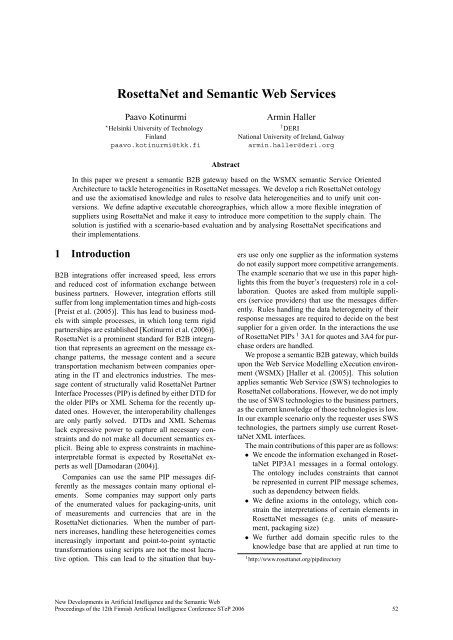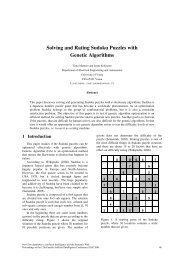New Developments in Artificial Intelligence and the Semantic Web
New Developments in Artificial Intelligence and the Semantic Web
New Developments in Artificial Intelligence and the Semantic Web
Create successful ePaper yourself
Turn your PDF publications into a flip-book with our unique Google optimized e-Paper software.
RosettaNet <strong>and</strong> <strong>Semantic</strong> <strong>Web</strong> ServicesPaavo Kot<strong>in</strong>urmi⋆ Hels<strong>in</strong>ki University of TechnologyF<strong>in</strong>l<strong>and</strong>paavo.kot<strong>in</strong>urmi@tkk.fiArm<strong>in</strong> Haller† DERINational University of Irel<strong>and</strong>, Galwayarm<strong>in</strong>.haller@deri.orgAbstractIn this paper we present a semantic B2B gateway based on <strong>the</strong> WSMX semantic Service OrientedArchitecture to tackle heterogeneities <strong>in</strong> RosettaNet messages. We develop a rich RosettaNet ontology<strong>and</strong> use <strong>the</strong> axiomatised knowledge <strong>and</strong> rules to resolve data heterogeneities <strong>and</strong> to unify unit conversions.We def<strong>in</strong>e adaptive executable choreographies, which allow a more flexible <strong>in</strong>tegration ofsuppliers us<strong>in</strong>g RosettaNet <strong>and</strong> make it easy to <strong>in</strong>troduce more competition to <strong>the</strong> supply cha<strong>in</strong>. Thesolution is justified with a scenario-based evaluation <strong>and</strong> by analys<strong>in</strong>g RosettaNet specifications <strong>and</strong><strong>the</strong>ir implementations.1 IntroductionB2B <strong>in</strong>tegrations offer <strong>in</strong>creased speed, less errors<strong>and</strong> reduced cost of <strong>in</strong>formation exchange betweenbus<strong>in</strong>ess partners. However, <strong>in</strong>tegration efforts stillsuffer from long implementation times <strong>and</strong> high-costs[Preist et al. (2005)]. This has lead to bus<strong>in</strong>ess modelswith simple processes, <strong>in</strong> which long term rigidpartnerships are established [Kot<strong>in</strong>urmi et al. (2006)].RosettaNet is a prom<strong>in</strong>ent st<strong>and</strong>ard for B2B <strong>in</strong>tegrationthat represents an agreement on <strong>the</strong> message exchangepatterns, <strong>the</strong> message content <strong>and</strong> a securetransportation mechanism between companies operat<strong>in</strong>g<strong>in</strong> <strong>the</strong> IT <strong>and</strong> electronics <strong>in</strong>dustries. The messagecontent of structurally valid RosettaNet PartnerInterface Processes (PIP) is def<strong>in</strong>ed by ei<strong>the</strong>r DTD for<strong>the</strong> older PIPs or XML Schema for <strong>the</strong> recently updatedones. However, <strong>the</strong> <strong>in</strong>teroperability challengesare only partly solved. DTDs <strong>and</strong> XML Schemaslack expressive power to capture all necessary constra<strong>in</strong>ts<strong>and</strong> do not make all document semantics explicit.Be<strong>in</strong>g able to express constra<strong>in</strong>ts <strong>in</strong> mach<strong>in</strong>e<strong>in</strong>terpretableformat is expected by RosettaNet expertsas well [Damodaran (2004)].Companies can use <strong>the</strong> same PIP messages differentlyas <strong>the</strong> messages conta<strong>in</strong> many optional elements.Some companies may support only partsof <strong>the</strong> enumerated values for packag<strong>in</strong>g-units, unitof measurements <strong>and</strong> currencies that are <strong>in</strong> <strong>the</strong>RosettaNet dictionaries. When <strong>the</strong> number of partners<strong>in</strong>creases, h<strong>and</strong>l<strong>in</strong>g <strong>the</strong>se heterogeneities comes<strong>in</strong>creas<strong>in</strong>gly important <strong>and</strong> po<strong>in</strong>t-to-po<strong>in</strong>t syntactictransformations us<strong>in</strong>g scripts are not <strong>the</strong> most lucrativeoption. This can lead to <strong>the</strong> situation that buyersuse only one supplier as <strong>the</strong> <strong>in</strong>formation systemsdo not easily support more competitive arrangements.The example scenario that we use <strong>in</strong> this paper highlightsthis from <strong>the</strong> buyer’s (requesters) role <strong>in</strong> a collaboration.Quotes are asked from multiple suppliers(service providers) that use <strong>the</strong> messages differently.Rules h<strong>and</strong>l<strong>in</strong>g <strong>the</strong> data heterogeneity of <strong>the</strong>irresponse messages are required to decide on <strong>the</strong> bestsupplier for a given order. In <strong>the</strong> <strong>in</strong>teractions <strong>the</strong> useof RosettaNet PIPs 1 3A1 for quotes <strong>and</strong> 3A4 for purchaseorders are h<strong>and</strong>led.We propose a semantic B2B gateway, which buildsupon <strong>the</strong> <strong>Web</strong> Service Modell<strong>in</strong>g eXecution environment(WSMX) [Haller et al. (2005)]. This solutionapplies semantic <strong>Web</strong> Service (SWS) technologies toRosettaNet collaborations. However, we do not imply<strong>the</strong> use of SWS technologies to <strong>the</strong> bus<strong>in</strong>ess partners,as <strong>the</strong> current knowledge of those technologies is low.In our example scenario only <strong>the</strong> requester uses SWStechnologies, <strong>the</strong> partners simply use current RosettaNetXML <strong>in</strong>terfaces.The ma<strong>in</strong> contributions of this paper are as follows:• We encode <strong>the</strong> <strong>in</strong>formation exchanged <strong>in</strong> RosettaNetPIP3A1 messages <strong>in</strong> a formal ontology.The ontology <strong>in</strong>cludes constra<strong>in</strong>ts that cannotbe represented <strong>in</strong> current PIP message schemes,such as dependency between fields.• We def<strong>in</strong>e axioms <strong>in</strong> <strong>the</strong> ontology, which constra<strong>in</strong><strong>the</strong> <strong>in</strong>terpretations of certa<strong>in</strong> elements <strong>in</strong>RosettaNet messages (e.g. units of measurement,packag<strong>in</strong>g size)• We fur<strong>the</strong>r add doma<strong>in</strong> specific rules to <strong>the</strong>knowledge base that are applied at run time to1 http://www.rosettanet.org/pipdirectory<strong>New</strong> <strong>Developments</strong> <strong>in</strong> <strong>Artificial</strong> <strong>Intelligence</strong> <strong>and</strong> <strong>the</strong> <strong>Semantic</strong> <strong>Web</strong>Proceed<strong>in</strong>gs of <strong>the</strong> 12th F<strong>in</strong>nish <strong>Artificial</strong> <strong>Intelligence</strong> Conference STeP 2006 52



